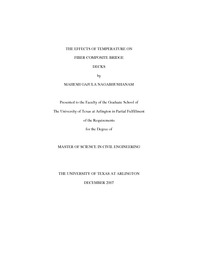
ATTENTION: The works hosted here are being migrated to a new repository that will consolidate resources, improve discoverability, and better show UTA's research impact on the global community. We will update authors as the migration progresses. Please see MavMatrix for more information.
Show simple item record
| dc.contributor.author | Gajula Nagabhushanam, Mahesh | en_US |
| dc.date.accessioned | 2008-08-08T02:31:02Z | |
| dc.date.available | 2008-08-08T02:31:02Z | |
| dc.date.issued | 2008-08-08T02:31:02Z | |
| dc.date.submitted | December 2007 | en_US |
| dc.identifier.other | DISS-1905 | en_US |
| dc.identifier.uri | http://hdl.handle.net/10106/898 | |
| dc.description.abstract | The use of Fiber composite honeycomb structure's as bridge decks gained importance, because of its low light weight and ease of installation.
In this study, The Fiber composite bridge decks were subjected to thermal gradients. The Fiber composite bridge decks were fabricated in sizes of 2 feet x 8 feet x .5 feet and 4 feet x 8 feet x .5 feet specimens by Kansas structural composites Inc. The program consisted of 3 specimens of size 2 feet x 8 feet x .5 feet with ribs oriented along longitudinal direction, 3 specimens of size 2 feet x 8 feet x .5 feet with ribs oriented along transverse direction and a specimen of size 4 feet x 8 feet x .5 feet with ribs oriented along transverse direction. Two Specimens with ribs oriented along longitudinal direction and two specimens with ribs oriented along transverse direction of size 2 feet x 8 feet x .5 feet were subjected to thermal loads greater than 120˚ F with unrestrained ends. Four tests were carried out on two specimens having ribs oriented along longitudinal direction and two specimens having ribs oriented along transverse direction with the shorter ends restrained. The top surface was exposed to constant temperature until the temperature and the strain linearize at the bottom surface of the Fiber composite deck. The decks were restrained using a mechanical setup made up of Fiber composite sections. A single specimen of size 4 feet x 8 feet x .5 feet was tested for thermal loads greater than 120˚ F with unrestrained ends. The strain readings were recorded using strain gage technology and the displacement was measured for specimens with restrained end using mm displacement sensor at the center span. A prototype of fiber composite deck was modeled using PRO-E and analyzed using
ANSYS FEM software. | en_US |
| dc.description.sponsorship | Ramirez, Guillermo | en_US |
| dc.language.iso | EN | en_US |
| dc.publisher | Civil & Environmental Engineering | en_US |
| dc.title | The Effect Of Temperature On Fiber Composite Bridge Decks | en_US |
| dc.type | M.S. | en_US |
| dc.contributor.committeeChair | Ramirez, Guillermo | en_US |
| dc.degree.department | Civil & Environmental Engineering | en_US |
| dc.degree.discipline | Civil & Environmental Engineering | en_US |
| dc.degree.grantor | University of Texas at Arlington | en_US |
| dc.degree.level | masters | en_US |
| dc.degree.name | M.S. | en_US |
| dc.identifier.externalLink | https://www.uta.edu/ra/real/editprofile.php?onlyview=1&pid=971 | |
| dc.identifier.externalLinkDescription | Link to Research Profiles | |
Files in this item
- Name:
- umi-uta-1905.pdf
- Size:
- 93.71Mb
- Format:
- PDF
This item appears in the following Collection(s)
Show simple item record


